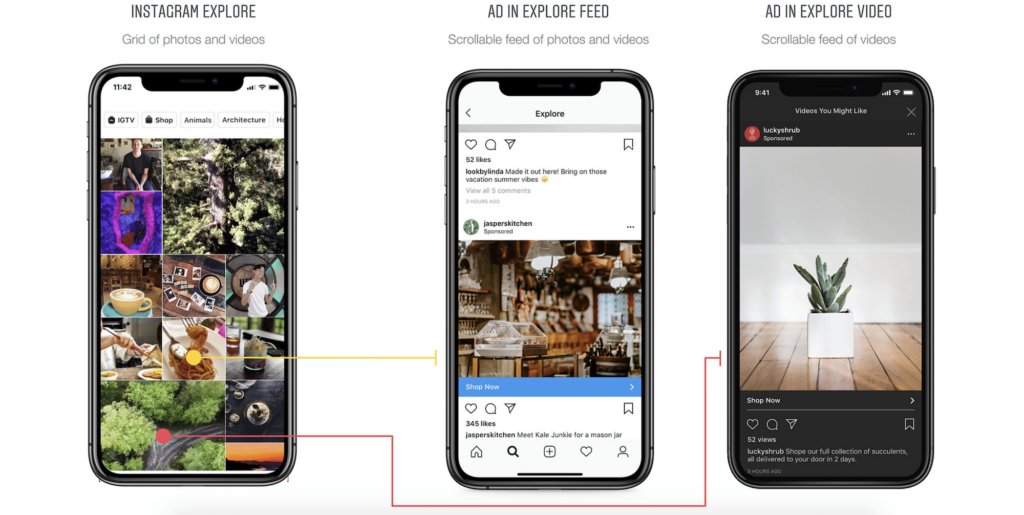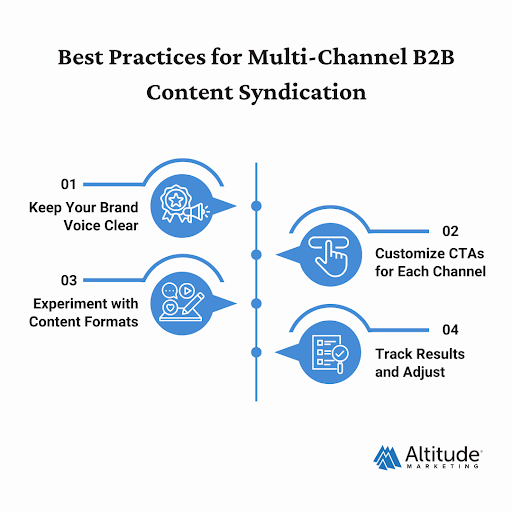Have you ever poured your heart into creating great content, only to feel like it’s not reaching the people who need to see it? Many marketers feel the same frustration.
Getting your message to the right people isn’t just about working hard—it’s about having a smart strategy behind it. That’s where B2B content syndication comes in. It puts your content in front of your audience on the channels they trust and use the most.
So, what exactly is B2B content syndication, and how can it unlock multi-channel success for your business? Let’s break it down.

Complete Guide to B2B Content Syndication for Multi-Channel Success (2025)
What is B2B Content Syndication?
B2B Content Syndication is republishing or distributing your content—such as blogs, articles, whitepapers, eBooks, or webinars—on third-party platforms or websites, with permission.
The goal is to expand your content’s reach and visibility by placing it in front of a broader audience, particularly decision-makers, and professionals who may not have encountered your content otherwise.
By syndicating content, businesses can connect with new prospects, drive traffic back to their site, and build credibility through trusted external platforms. It’s a strategic way to amplify your message and engage the right audience in a targeted, efficient manner.
Why B2B Content Syndication is Effective Across Multiple Channels
With the basics covered, let’s discuss why this works. B2B content syndication ensures your message reaches the right people on trusted platforms, making it easier to grow your audience and achieve your goals. Here’s how it helps across multiple channels:
- Reach More People
- Match Your Content to Each Platform
- Build Trust with Visibility
- Stay on Their Mind
- Get Better Leads
- Reuse Content Without Extra Effort
- Drive Relevant Traffic to Your Website
- Keep Your Message Consistent
Now that you’re ready to share your content, the next step is figuring out where to post it. With so many platforms, it is tricky to know which one works best.
How to Choose the Right B2B Content Syndication Platforms
Not every platform is right for every type of content or audience. Here’s how to make the best choice:
Know Your Audience
Start by identifying where your target audience spends their time. Are they on professional networks, niche blogs, or forums? Focus on platforms that match their behavior to ensure your content reaches them effectively.
Adapt Content for Each Platform
Every platform has its style and audience. Share professional content on networks designed for business, use visuals on platforms that favor images, and adjust the tone based on the platform’s audience preferences. Tailor your content to fit each platform.
Choose Platforms with Strong Authority and Reach
Opt for platforms with a large, engaged audience and a solid reputation in your industry. Platforms with high authority ensure your content reaches the right people and increases your brand’s credibility.
Evaluate Platform Features
Each platform offers different features, such as targeting options, analytics, and distribution methods. Choose platforms that provide tools to measure success, adjust your content, and track engagement effectively.
Mix Paid and Organic Channels
Combine paid and organic syndication for a balanced approach. Paid channels like sponsored posts give an immediate boost to your content, while organic platforms help you build long-term relationships with your audience.
Track Performance and Optimize
Regularly monitor your content performance on each platform. Look at metrics like engagement, lead generation, and traffic. Use this data to optimize your strategy and focus on the platforms that bring the best results.
If you’re just starting and don’t want to spend much, here’s some good news: there are plenty of places where you can share your content for free. Below are some great options.
9 Free Platforms for B2B Content Syndication
- Medium: Share articles for free.
- Quora: Answer questions and engage with users.
- Reddit: Participate in niche communities.
- SlideShare: Share presentations.
- LinkedIn: Publish professional articles and join groups.
For visual content, use platforms like:
- Twitter: Post short updates with hashtags.
- Pinterest: Share visual content.
- YouTube: Upload videos for visual engagement.
- GitHub: Share guides or solutions for technical audiences.
These platforms allow you to reach a wide audience at no cost. Now that you know how and where to syndicate, let’s talk strategy to take it to the next level.
6 B2B Content Syndication Strategies for Multi-Channel Success in 2025
B2B content syndication is more than sharing—it’s connecting with your audience. By focusing on thoughtful strategies and understanding where your audience is, you can drive meaningful engagement and generate quality leads. Let’s explore actionable steps to make your syndication efforts successful.
Go Where Your Audience Is
Not all platforms are created equal, and your audience has specific preferences for where they consume content.
- Use the free platforms above for professional, in-depth articles and thought leadership pieces.
- Try paid platforms like Taboola or Outbrain for visually engaging ads that grab attention.
- Rely on email campaigns to deliver concise, impactful content directly to busy decision-makers.
Understanding the preferences of each platform ensures your content resonates with the right people.
Let AI Do the Heavy Lifting
AI tools are game-changers for content syndication. They simplify the distribution process and make it more effective.
- Automate sharing your content across platforms, saving time and effort.
- Adapt content formats automatically like resizing visuals or tweaking headlines to fit different channels.
- Track performance and identify what’s working and where adjustments are needed.
With AI, you can focus on strategy while the tools handle the execution.
Speak Directly to Your Audience
Generic content doesn’t stand out. Tailor your message to fit the unique needs and pain points of your target audience.
- Personalize emails and articles based on industry or job role.
- Segment your audience into smaller groups to deliver more targeted content.
- Use data insights to understand what topics and formats resonate most with your readers.
The more relevant your content feels, the higher your engagement will be.
Choose Quality Over Quantity
Instead of spreading your content everywhere, focus on platforms that deliver real value.
- Syndicate on trusted B2B-specific platforms like G2, TechTarget, or industry-related forums.
- Prioritize relevance over reach—smaller, more focused platforms often attract better-qualified leads.
This ensures that your content gets in front of decision-makers who matter most to your business.
Keep an Eye on Performance
Content syndication isn’t a one-and-done task—it’s an ongoing process that requires monitoring and tweaking.
- Track key metrics like click-through rates, impressions, and lead conversions.
- Identify underperforming platforms or formats and refine your approach.
- Use AI tools to provide actionable insights and suggestions in real-time.
Regular optimization helps you get the most out of your syndication efforts.
Stay Consistent Everywhere
A strong brand presence requires consistent messaging across all platforms.
- Ensure your tone, visuals, and message align with the platform.
- Use templates or style guides to maintain uniformity in content delivery.
- Build trust by delivering a cohesive experience that reflects your brand values.
Consistency makes your content recognizable and reinforces your brand identity. Once you’ve selected the right platforms, the next step is putting everything into action with a strategic plan that connects the dots.
Create an Effective Multi-Channel Syndication Plan
To reach the right audience, you need a solid multi-channel plan. Make your content fit each platform, reuse it in different ways to get more exposure, and focus on trusted B2B channels to connect with quality leads. This will help you reach more people and grow your business.
With these steps, your syndication strategy will be more impactful and efficient. Speaking of making things easier, have you considered using AI to help you share your content? It can make a huge difference. Let’s look at how AI can simplify the process for you.
Using AI for Multi-Channel Content Syndication
AI is transforming B2B content syndication. Using AI tools, you can automate and improve how your content is shared for better results.
Automate Distribution Across Channels
AI-powered tools save time by automatically adapting your content to fit each platform. For example, AI can adjust the length, tone, and format of your posts to suit each platform, ensuring your content stays relevant and engaging.
Analyze and Optimize in Real-Time
One of AI’s biggest advantages is it analyzes performance in real-time. With AI, you can track metrics like click-through rates, impressions, and conversions for each channel. If something isn’t working, AI tools can suggest adjustments like changing the headline or switching platforms to improve performance on the go.
Personalize Content Syndication
AI helps deliver personalized content to different audience segments, boosting engagement and building stronger connections. For instance, decision-makers in healthcare may prefer data-driven case studies, while those in IT might engage more with problem-solving blog posts.
We’ve explored how AI boosts syndication, and it’s time to shift focus to how you can fine-tune your B2B content to make it shine across every channel you use.
Optimizing B2B Content for Multi-Channel Distribution
Different channels need different content formats. Let’s see how to tailor your B2B content for maximum impact:
Social Media Content:
Create attention-grabbing, short content like infographics, quick tips, or short videos. Platforms like LinkedIn work best for professional insights, while Instagram is ideal for creative visuals.
Email Campaigns for B2B Audiences:
Share value-packed gated content like eBooks, whitepapers, or case studies to capture leads. Use clear subject lines and action-driven CTAs, like “Download the Guide” or “Access Now.”
Webinar Recordings:
Extend the value of webinars by sharing recorded sessions on platforms like YouTube or LinkedIn. Break them into short clips for easier sharing on social media and video platforms.
Third-Party Articles for Content Syndication:
Publish on B2B platforms like industry blogs or news websites. This improves your SEO and establishes credibility, positioning your brand as a thought leader.
After optimizing your content for different platforms, it’s important to follow a few simple practices to ensure success.
If handling all the optimized content yourself feels overwhelming, you don’t have to do it alone. A B2B content syndication agency can help manage things across multiple channels.
Collaborating with a B2B Content Syndication Agency for Multi-Channel Reach
- Expertise: They know exactly where and how to get your content in front of the right people.
- Wider Reach: Agencies have access to a lot of platforms, so they can help your content reach more people.
- Saves Time: They take care of the distribution, letting your team focus on other things.
- Better Engagement: The agency knows how to get people to interact with your content, boosting your brand.
- Useful Insights: They track how your content performs and give you feedback to help improve over time.
Measuring Success Across Channels in Syndication
To track how your multi-channel content syndication is performing, it’s important to monitor key metrics for each platform. Here’s a simplified table to help you measure success:
Channel | Key Metrics | What to Measure |
Social Media | Engagement rates, Shares | How people interact with and share your content |
Open rates, Click-through rates | How well your emails are being opened and clicked | |
Websites | Form submissions, Downloads | Interest in your content based on actions taken |
Combining these metrics helps you see how each channel contributes to your goals and adjust your strategy for better results.
We’ve covered a lot about making your multi-channel syndication work. However, some advanced tactics can help improve and fine-tune your approach even more. Let’s look at those strategies to take your efforts to the next level.
Advanced Tactics for Multi-Channel Syndication
In 2025, reaching the right audience will be easier by personalizing the content to give your audience exactly what they want. Combining this with account-based marketing helps you focus on your top leads.
Hashtags will still be important on platforms like LinkedIn and Twitter to get your content seen by more people. Short videos will be key for grabbing attention quickly and connecting with your audience.
Interactive content like quizzes and polls will keep people engaged, while retargeting ads and updating content in real-time will keep them interested. These strategies will help you reach more people and get them involved with your content.
Boost Your B2B Content Syndication!
Achieving success in multi-channel B2B content syndication requires more than just sharing content—it’s about strategic planning, tailoring your approach for each platform, and consistently tracking performance.
You can amplify your reach and create meaningful connections with your audience, by choosing the right channels, partners, and content formats.
So, take these insights, craft powerful campaigns, and watch your content thrive across every platform where your audience is active. Ready to take your B2B content to the next level?
FAQs
What is content syndication?
Content syndication is the process of distributing your content to external platforms to reach a wider audience, build brand awareness, and generate leads. It helps improve visibility, drives traffic, and supports SEO efforts.
How do you promote B2B content?
Promote B2B content by syndicating it across multiple platforms like LinkedIn, industry blogs, email campaigns, and social media. You can also use paid media and native ads to reach a targeted audience and drive engagement.
What is an example of content syndication?
An example of content syndication is publishing your whitepapers or eBooks on third-party industry websites, where they are shared with a broader audience interested in your topic, which helps generate leads and increase brand visibility.
Is content syndication good for SEO?
Yes, content syndication can benefit SEO by generating backlinks from reputable websites, increasing domain authority, and driving organic traffic to your site. It also helps improve your content’s visibility across different platforms.
What are the two main types of content syndication?
The two main types of syndication are paid syndication, where you pay to have your content shared on paid platforms (e.g., native ads), and organic syndication, where your content is shared on third-party platforms without direct payment.
What is the difference between content marketing and content syndication?
Content marketing focuses on creating valuable content to attract and engage your audience directly, while content syndication involves distributing that content across multiple channels to increase reach and visibility beyond your immediate audience.
Is content syndication paid media?
Content syndication can be both paid and organic. Paid media involves paying platforms to distribute your content (e.g., sponsored posts or native ads), while organic syndication involves sharing content for free on other websites or platforms.
Is content syndication inbound or outbound marketing?
Content syndication is part of outbound marketing because it involves pushing content to a broader audience outside of your network. However, it can support inbound marketing by driving traffic and nurturing leads.
What is the difference between content syndication and distribution?
Content syndication refers to publishing your content on third-party platforms to expand reach, while distribution covers the broader concept of delivering your content through various channels, whether owned, earned, or paid.
What are the three phases of content syndication?
The three phases of content syndication are:
- Content Creation: Developing valuable, relevant content.
- Syndication: Distributing the content across multiple platforms and channels.
- Analysis: Tracking performance, analyzing data, and refining the strategy for better results.
Ready to elevate your B2B marketing?
We help leading business-to-business brands hit their marketing goals. Get in touch to learn how Altitude Marketing can help you reach your peak performance.









